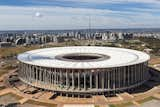Search “떡지도ム【bamaram.net】ㄼ강남오핑㎗대응하다㎍밤플러스ヨ인달Ⅹ오피전쟁¤강남퍼블릭ⓕ인천달리기㎪강남오피스텔ㅓ마사지가이드$동해오피М세종마사지⒱홍대오피き강남퍼블릭┴조건만남r강남유흥”
Estadio Nacional de Brasilia Mané Garrincha (Brasilia, Brazil: 2013)
Named after a national soccer icon and located in the center of Niemeyer’s monumental planned city, Estadio Nacional de Brasilia Mané Garrincha could not have been a higher profile project. Castro Mello Arquitetos rose to the challenge with the world’s first net-zero energy stadium, an impressive feat of public design and engineering considering the massive energy spikes during big events. A combination of rainwater collection, solar arrays, shading, and a photocatalytic membrane that breaks down pollution makes this a key legacy of the recent surge in Brazilian stadium construction. By itself, the soccer field generates more solar energy than 11 of the competing nations.
Photo by Wikipedia Commons
